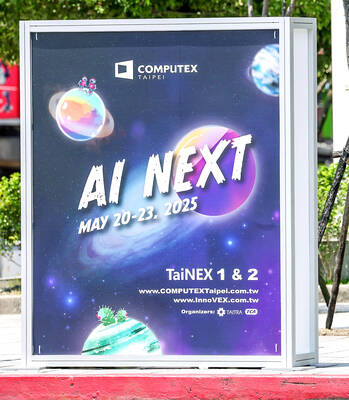US lawmakers voiced awe last week at taking a ride on Japan’s sleek bullet trains, with one congressman saying he felt like he was in a videogame.
At a congressional hearing, Representative Don Manzullo said he took the ultra-fast train from the central city of Nagoya, where he visited Toyota Motor Corp and other companies, to Tokyo.
“I got to sit right up in front,” the Illinois Republican said of his trip two years ago.
“It was almost like a videogame,” he added. “You have to try that sometime.”
Eni Faleomavaega, who heads the House Foreign Affairs subcommittee on Asia, contrasted Japan’s trains with the US’ own troubled network.
“The fact of the matter is Japan is about 100 years in advance as far as mass transit system compared with ours,” said Faleomavaega, a Democrat who represents American Samoa.
“They were able to have trains that can go up to speeds of 125 miles (200km) an hour some 50 years ago. And what are we doing?”
But Representative Ed Royce, a Republican from car-loving southern California, begged to differ, saying that public transport was “very rational” for Japan but not necessarily for the US.
“Japan’s population, its density, its geography, make it entirely different when discussing public transportation than with respect to the United States,” Royce said.
“We look at economic merit when addressing infrastructure.”
President Barack Obama in January unveiled US$8 billion in economic stimulus money aimed at building high-speed rail networks in the US.
(AFP)
美國國會議員上週盛讚搭乘日本流線型子彈列車的經驗,有位議員還表示,整個人宛若置身電玩遊戲之中。
眾議員唐恩•曼祖羅在眾院聽證會上表示,他到日本中部名古屋市拜訪豐田汽車和其他公司,順道搭乘高速列車前往東京。
這位伊利諾州共和黨眾議員說起兩年前這趟日本行時表示:「當時我坐在最前面。」
他還說:「整個就像一場電玩遊戲。有機會你們一定要試試。」
美國聯邦眾議院外交委員會亞太小組主席恩尼•法雷歐馬維加,拿日本列車和問題重重的美國鐵路網來對比。
身為薩摩亞裔民主黨員的法雷歐馬維加說:「事實上,日本在大眾運輸系統方面領先我們一百年左右。」
「他們大概五十年前就能打造出時速達一百二十五英里(兩百公里)的列車了。我們呢?」
愛德•羅艾斯眾議員則不以為然地表示,大眾運輸對日本來說是「極為明智」的選擇,但在美國並非絕對必要。羅艾斯是南加州共和黨議員,當地人偏好自行開車。
羅艾斯說:「日本的人口數、人口密度及地理環境和美國截然不同,在討論大眾運輸議題時,自然不可等同視之。」
「處理基礎建設問題時,我們考量的是經濟價值。」
巴拉克•歐巴馬總統一月時宣布,要從經濟振興基金中提撥八十億美元興建美國高鐵網絡。(法新社╱翻譯:林倩如)

Computex, Asia’s biggest electronics conference, kicked off Monday in Taipei, and as in years past drew industry chieftains from Nvidia Corp.’s Jensen Huang and Qualcomm Inc.’s Cristiano Amon to Young Liu of Foxconn, which makes the bulk of the world’s iPhones and Nvidia servers. But while last year’s event was a celebration of the post-ChatGPT AI boom, executives this time are likely grappling with the uncertainty of the Trump administration’s effort to reshape the global trade order — disrupting a decades-old model for tech manufacturing. This year’s exhibition will of course feature the hardware required to bring artificial intelligence to life.

Dog owners often wish they could understand their pets’ thoughts. “Dog buttons” might turn their dream into a reality. These specially designed buttons, __1__ sound chips, enable dogs to communicate their needs by pressing buttons corresponding to pre-recorded words like “walk,” “play,” “outside,” and “food.” This bridges the communication __2__ between humans and their canine companions. The science behind dog buttons is based on the concept of associative learning. It’s a process __3__ learners can link actions with outcomes. For instance, if an owner consistently presses the “walk” button and then takes their dog for a walk, the dog

For many people, allergies are an all-too-familiar annoyance. The constant sneezing, itching, and watery eyes are just a few clear signs of allergies, which is a surprisingly common condition affecting millions worldwide. But what exactly triggers these reactions, and how can we cope with them? Allergies arise from a misunderstanding between our immune system and seemingly harmless substances. Under normal circumstances, the immune system acts as our body’s personal bodyguard, diligently identifying and eliminating threats like viruses and bacteria. However, in individuals with allergies, the immune system mistakenly identifies certain substances, called allergens, as invaders. This triggers a reaction, leading to

1. 眾所皆知,資訊產業是我國經濟的基礎。 ˇ As everyone admits, the IT industry is the backbone of our economy. χ As everyone admits that the IT industry is the backbone of our economy. 註:這裏 as 作關係代名詞,引導從屬子句。誤句多了 that, IT industry is. . . 就變成從屬句,欠缺了主句,結構上錯誤。又如: As my friend pointed out, necessity is the mother of invention. As is known to all, grammar is not the only important thing in language study. 2. 她心情總是非常好。 ˇ She is always in a good mood. χ She always is in a good mood. 註:always, often 一般放在行為動詞之前,連繫動詞、助動詞之後: He always behaves well. He is always happy and gay. He is always reading. 其他用法類似的副詞,還有 still、also、hardly、seldom、never 等。 3. 你看!他還在寫報告呢。 ˇ Look! He is still working